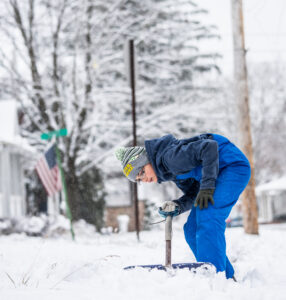‘Serious concerns’: Opponents of egg farm proposal offer testimony of possible effect on residents’ water

Hydrogeologist Richard Henry testifies about where be believes ground water will drain into bed rock aquifers eventually from the proposed site of a CAFO in Muncy Twp. during at the Muncy Creek Township Supervisors at the Muncy Area Volunteer Fire Company in Muncy. DAVE KENNEDY/Sun-Gazette
Chicken manure outside of barns could pose a risk to enter the water table and those contaminants getting into municipal and private wells.
That’s what hydrogeologist Richard Henry warned could be possible based on information he was given about the proposed Sunny Side Up Farms LLC project on Clarkstown Road in Muncy Creek Township.
“Given the information and details that were provided to me thus far . . . I would have to say there is risk on all sides — that need to be addressed,” said Henry, who is a witness testifying on behalf of the Muncy Area Neighborhood Preservation Coalition, a grassroots citizens organization consisting of many residents who live within a mile or less of the proposed agrivoltaic project.
He was continuing with his testimony at the conditional use hearing for the proposed Sunny Side Up Farms, a joint venture consisting of five barns each housing 70,000 free-range, cage-free chickens for laying eggs along with a 33-megawatt solar panel facility. The CAFO would be operated by a company called AgVentures.
“There are serious concerns for adverse consequences here,” Henry said.
Most “flagrant” were what could happen from the two CAFO barns located on the southeastern part of the proposed project.
It was “a lot of activity” in a very small area — with a “close downgradient receptor” — an unnamed tributary, later identified for the record as Kiess Run.
Similarly, the project plan shows three more proposed barns off to the west and Henry said he was concerned about potential risk from these barns to the north, where a downgradient receptor is a “municipal well.”
Each time before he explained the risk, Henry took those at the hearing on a deep-dive into hydrogeological formations beneath and on the site and nearby properties.
He discussed such terms as an “alluvial aquifer,”a potential receptor underground for contamination should there be any overloading of manure on soil that might get into the groundwater system.
“The alluvial aquifer is a primary recharge mechanism for the underlying bedrock aquifer, which is where well over 90 % of the well water users in this area get their water,” he said.
It was an apparent revelation for many in the audience, some who get their water in private wells.
“What I am understanding, and correct me if I am wrong, but that is the mechanism from a hydrogeological standpoint to which the groundwater can potentially become contaminated from surface contamination?” asked Attorney Zachary DuGan, counsel on behalf of the coalition.
“Yes,” Henry replied. “The alluvial aquifer in this case is going to be the initial receptor for any contamination,” he said. Once it goes through the soil, the first place it is going to reside is this alluvial aquifer, he added.
The aquifer acts as a “recharge to the underlying bedrock,” Henry said, as a potential flow path for potential contamination to reach.
Henry acknowledged that he was not an expert in manure management, but offered an assumption calculation on how much manure a hen can lay in a year. It was based on about 1.6 acres for each grazing area and other factors.
He came up with 60 pounds of manure per year per hen. He did so, he said, by knowing the size of the pasture and the number of hens.
“I thought that was problematic,” Henry said.
Chicken manure has ammonia nitrate in it and microbiologicals or bacteria.
Additionally, he pointed out that too much of a load of manure can lead to plants dying off and the ground becoming dirt, potentially causing a problem with soil erosion as there is no more grass in that case.
“Very little buffer or no room to mitigate what contaminants may be there,” he said.
Some residents live along the run and have private water sources.
If contamination occurs, could those properties be affected? DuGan asked Henry.
In his answer, his concern was if contamination would reach the alluvial aquifer. He also was concerned about possible contamination of groundwater by chicken manure getting through soil and into the supply for a hand-dug well on a horsebarn due north and just south of Clarkstown Road. He noted how the tributary had minnows in it – a form of aquatic life.
Moreover, he explained how there is a public well source north of the project which is identified as Muncy Municipal Authority well number 8. There also was a municipal well number 7 to the west, which was not as close as well 8, but was considered close enough but not listed on the map displayed. There also was a neighbor property with a spring and a pond that could be impacted if contamination would occur.
“Three barns in the center of the property could pose risk to the Muncy municipal water supply which provides 200-gallons-per-minute and is half mile downgradient of the proposed CAFO site,” he said.
Under cross-examination by the client’s Attorney Samuel Wiser Jr., the attorney noted the manure calculation did not account for issues such as the 12 weeks when the birds are brought to the farm that they do not go outside of the barns.
“No, I was not aware of that,” Henry said.
Henry also acknowledged that he recalled testimony that the chickens do not go outdoors when it reaches 90 degrees outside. The birds also do not venture out if it gets too cold outside.
“Did you calculate any offset of how many average days per year are above 90 days a year when the birds would not be outside?” Wiser asked, also asking him about the cold weather offset as well.
“No, I didn’t,” Henry said, acknowledging that would be basic modeling, which he said he was not qualified to do.
The project is required to follow strict state regulatory law regarding nutrient management, odor control, and soil and erosion control, and many other regulatory steps to meet to ensure there is a plan in place should there be contamination discovered, according to prior testimony.
Henry frequently observed how the project, as presented, lacked details on how stormwater management and erosion control would be handled.
The proposed barns would encompass about 1.25 acres a piece and 3.2 acres of pasture area per barn, according to the plan.
Henry expressed his concern about how rainwater or precipitation off the CAFO barns would be corralled.
He expressed concern about the potential contamination from stormwater and surface water runoff flowing off the parcel with the two barns on the southeast portion of the property. Water could potentially funnel from here into the tributary (Kiess Run) There was, as he described, “little space” to accommodate stormwater management” in this area.
Rain coming off the roofs and into the pasture warrants such management, he added.
Wiser also noted through questioning that there are some private residences with septic tanks that Henry acknowledged can pose a risk to well contamination.
Henry also was asked and acknowledged the fact that there was surrounding crop land, such as land planting with soybeans, which could also contribute to potential contamination entering surrounding well systems.
For those interested, the next solar panel portion of the project hearing is Oct. 29 at 7 p.m. and the next CAFO hearing is scheduled for 7 p.m. Nov. 19.


